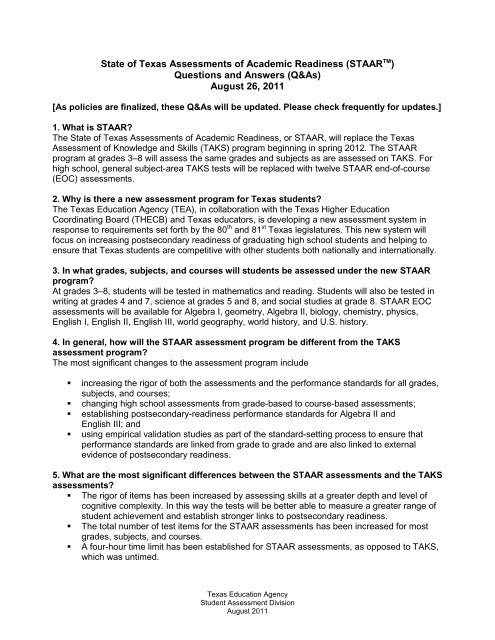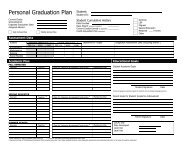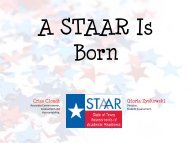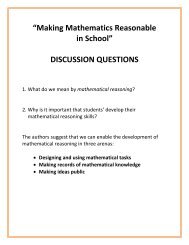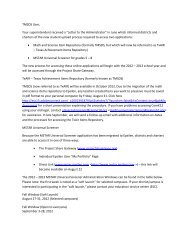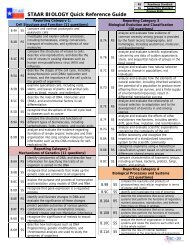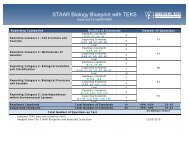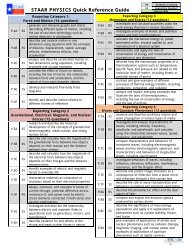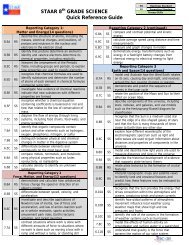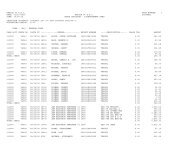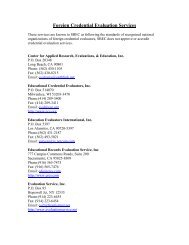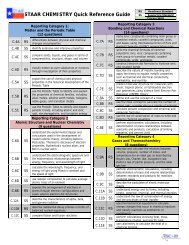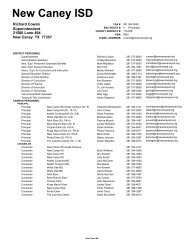staar
staar
staar
Create successful ePaper yourself
Turn your PDF publications into a flip-book with our unique Google optimized e-Paper software.
State of Texas Assessments of Academic Readiness (STAAR TM )<br />
Questions and Answers (Q&As)<br />
August 26, 2011<br />
[As policies are finalized, these Q&As will be updated. Please check frequently for updates.]<br />
1. What is STAAR?<br />
The State of Texas Assessments of Academic Readiness, or STAAR, will replace the Texas<br />
Assessment of Knowledge and Skills (TAKS) program beginning in spring 2012. The STAAR<br />
program at grades 3–8 will assess the same grades and subjects as are assessed on TAKS. For<br />
high school, general subject-area TAKS tests will be replaced with twelve STAAR end-of-course<br />
(EOC) assessments.<br />
2. Why is there a new assessment program for Texas students?<br />
The Texas Education Agency (TEA), in collaboration with the Texas Higher Education<br />
Coordinating Board (THECB) and Texas educators, is developing a new assessment system in<br />
response to requirements set forth by the 80 th and 81 st Texas legislatures. This new system will<br />
focus on increasing postsecondary readiness of graduating high school students and helping to<br />
ensure that Texas students are competitive with other students both nationally and internationally.<br />
3. In what grades, subjects, and courses will students be assessed under the new STAAR<br />
program?<br />
At grades 3–8, students will be tested in mathematics and reading. Students will also be tested in<br />
writing at grades 4 and 7, science at grades 5 and 8, and social studies at grade 8. STAAR EOC<br />
assessments will be available for Algebra I, geometry, Algebra II, biology, chemistry, physics,<br />
English I, English II, English III, world geography, world history, and U.S. history.<br />
4. In general, how will the STAAR assessment program be different from the TAKS<br />
assessment program?<br />
The most significant changes to the assessment program include<br />
increasing the rigor of both the assessments and the performance standards for all grades,<br />
subjects, and courses;<br />
changing high school assessments from grade-based to course-based assessments;<br />
establishing postsecondary-readiness performance standards for Algebra II and<br />
English III; and<br />
using empirical validation studies as part of the standard-setting process to ensure that<br />
performance standards are linked from grade to grade and are also linked to external<br />
evidence of postsecondary readiness.<br />
5. What are the most significant differences between the STAAR assessments and the TAKS<br />
assessments?<br />
The rigor of items has been increased by assessing skills at a greater depth and level of<br />
cognitive complexity. In this way the tests will be better able to measure a greater range of<br />
student achievement and establish stronger links to postsecondary readiness.<br />
The total number of test items for the STAAR assessments has been increased for most<br />
grades, subjects, and courses.<br />
A four-hour time limit has been established for STAAR assessments, as opposed to TAKS,<br />
which was untimed.<br />
Texas Education Agency<br />
Student Assessment Division<br />
August 2011
STAAR assessments in mathematics and reading will be linked from grade to grade as well<br />
as to postsecondary-readiness standards for the Algebra II and English III assessments.<br />
STAAR assessments have been designed to focus on ―readiness‖ standards, which are<br />
defined as those Texas Essential Knowledge and Skills (TEKS) student expectations that<br />
are not only essential for success in the current grade or course but also important for<br />
preparedness in the next grade or course. By focusing on the student expectations that are<br />
most critical to assess, STAAR will better measure the academic performance of students<br />
as they progress from elementary to middle school to high school.<br />
STAAR EOC assessments will differ from the current TAKS high school assessments in<br />
that each STAAR EOC assessment will cover only the content from a particular course<br />
(e.g., Algebra I will assess only Algebra I content) rather than content from multiple courses<br />
(e.g., Algebra I and grade 8 mathematics were assessed on the TAKS grade 9<br />
mathematics tests).<br />
STAAR writing assessments at grades 4 and 7 will be extended to two days.<br />
STAAR EOC assessments for English I, II, and III will be administered over two days, with<br />
the writing component on day one and the reading component on day two.<br />
The test designs for STAAR grades 4 and 7 writing and STAAR English I, II, and III will<br />
require students to write two essays addressing different purposes for writing rather than<br />
one longer personal essay, which TAKS required.<br />
In reading assessments for STAAR, greater emphasis will be given to critical analysis<br />
rather than literal understanding. The test designs for English I, II, and III will allow for the<br />
reading and writing components to be equated and scaled separately so that reading and<br />
writing scores can be reported separately. This means that a student will need to retake<br />
only the portion of the STAAR English I, II, or III assessment (reading or writing) that he or<br />
she did not pass.<br />
Most STAAR mathematics and science assessments will have an increased number of<br />
open-ended (griddable) items to allow students the opportunity to derive an answer<br />
independently without being influenced by the answer choices provided with the questions.<br />
STAAR grade 3 assessments will have separate answer documents instead of scorable<br />
test booklets.<br />
6. How will student performance be described on STAAR?<br />
There will be two cut scores, which will identify three performance categories. For the general<br />
STAAR assessments, STAAR Modified, and STAAR L, the labels for the performance categories<br />
are<br />
Level III: Advanced Academic Performance<br />
Level II: Satisfactory Academic Performance<br />
Level I: Unsatisfactory Academic Performance<br />
For the STAAR Alternate assessments, the performance labels are<br />
Level III: Accomplished Academic Performance<br />
Level II: Satisfactory Academic Performance<br />
Level I: Unsatisfactory Academic Performance<br />
7. What is the timeline for establishing student performance standards for the STAAR<br />
program?<br />
The timeline for standard–setting activities will differ for STAAR 3–8 and STAAR EOC because of<br />
the timing of available assessment data and different legislative requirements. For STAAR EOC,<br />
operational assessment data are available from the spring 2011 administrations. Therefore,<br />
Texas Education Agency<br />
Student Assessment Division<br />
August 2011
performance standards will be set in February 2012, prior to the spring administrations. However,<br />
operational assessment data for STAAR 3–8 will not be available until after the spring 2012<br />
administrations; for this reason performance standards will be set in October 2012.<br />
Legislation requires a system of performance standards that are linked from grade to grade starting<br />
with postsecondary-readiness performance standards down through grade 3. Therefore, STAAR<br />
EOC performance standards must be established before standards for STAAR 3–8 can be set.<br />
Additionally, districts must be provided with test scores on STAAR EOC assessments so that they<br />
can be used as 15% of the students’ final course grades for the 2011−2012 school year.<br />
8. What are the Student Success Initiative (SSI) requirements for the 2011–2012 school<br />
year?<br />
Because there will be no performance standards in place for grades 3–8 in the 2011–2012 school<br />
year, students cannot be held subject to SSI for that year. Therefore, there are no SSI<br />
requirements for the 2011–2012 school year.<br />
9. Will there be SSI retest opportunities for grades 5 and 8 reading and mathematics in the<br />
2011–2012 school year?<br />
SSI retest opportunities will not be offered in May or June of 2012 because performance standards<br />
for STAAR 3–8 will not be set until October 2012. For the 2011–2012 school year, districts will<br />
make promotion/retention decisions based on the same academic information (e.g., the<br />
recommendation of the student’s teacher and the student’s grade in the subject) used to make<br />
these decisions in non-SSI grades. As stated in TEC §28.021(a), ―a student may be promoted only<br />
on the basis of academic achievement or demonstrated proficiency of the subject matter of the<br />
course or grade level.‖<br />
10. Which students will be required to take the STAAR EOC assessments?<br />
Students first enrolled in grade 9 or below in the 2011–2012 school year will be required to take the<br />
STAAR EOC assessments for courses in which they’re enrolled as part of their graduation<br />
requirements and will no longer take TAKS. Students enrolled in grade 10 or above in the 2011–<br />
2012 school year or who are repeating grade 9 in the 2011–2012 school year will graduate under<br />
TAKS requirements and do not have the option of taking STAAR assessments. These students will<br />
only take STAAR EOC assessments if their campus has been assigned to participate in the<br />
mandatory testing activities.<br />
11. What are the testing requirements for students who repeat grade 9 in the 2011–2012<br />
school year?<br />
Repeating grade 9 students in the 2011–2012 school year have TAKS as their graduation<br />
requirement. These students will not take the TAKS grade 9 assessments, as these tests are no<br />
longer available. However, districts may choose to administer a released TAKS test or a locally<br />
developed test to students. Students are eligible to take the TAKS grade 10 assessments as soon<br />
as they are reclassified as 10 th graders.<br />
12. What are the testing requirements for students in grades 3–8 who are also enrolled in a<br />
high school course with a STAAR EOC assessment?<br />
Students in grades 3–8 who are also enrolled in a high school course will take that STAAR EOC<br />
assessment as required for graduation. Local district policies will determine whether these students<br />
are required to take the corresponding STAAR grade-level assessment; however, they must take<br />
all other STAAR grade-level assessments. For example, a grade 8 student enrolled in Algebra I will<br />
take STAAR grade 8 reading, science, and social studies as well as STAAR Algebra I. Local<br />
Texas Education Agency<br />
Student Assessment Division<br />
August 2011
school district policy will determine whether this grade 8 student will also take the STAAR grade 8<br />
mathematics assessment.<br />
Students in grades 5 and 8 may not be denied promotion based on unsatisfactory performance on<br />
STAAR EOC assessments.<br />
Note that this information reflects the language in House Bill 2135, which was passed by the 82 nd<br />
Legislature, and is different from what was indicated in the April 22, 2011, district communication<br />
regarding the implementation of STAAR. Districts should keep in mind that decisions have not yet<br />
been made about how test scores for these students will be used in state or federal accountability.<br />
13. What are the testing requirements for students in grades 3–8 who are receiving<br />
instruction in subjects above their enrolled grade?<br />
These students will be required to take the STAAR assessment for the subject in which they are<br />
receiving instruction if the content covers the entire curriculum for that subject. For example, a<br />
student in grade 5 who is receiving instruction in grade 6 mathematics would take STAAR<br />
grade 5 reading and science but grade 6 mathematics if the advanced subject matter he or she is<br />
being taught covers all the TEKS required for grade 6 mathematics.<br />
Students in grades 5 and 8 may not be denied promotion based on unsatisfactory performance on<br />
STAAR assessments above their enrolled grade level.<br />
Districts should keep in mind that decisions have not yet been made about how test scores for<br />
these students will be used in state or federal accountability.<br />
14. How are the STAAR EOC assessments related to course grades?<br />
The score a student receives on a STAAR EOC assessment is required to count for 15% of the<br />
student’s final grade in the course. Since grading policies are determined locally and TEA lacks<br />
statutory authority in this area, districts should establish local policies to implement this statutory<br />
requirement. For the STAAR English I, II, and III assessments, which have a separate reading and<br />
writing component, districts have discretion over how the scores from each component are used to<br />
calculate the 15% grading requirement. TEA is not planning to provide a method by which scale<br />
scores can be converted into grading systems because of wide variations in grading policy from<br />
district to district.<br />
There is no corresponding requirement for students taking a modified or alternate assessment, so<br />
districts are not required to count STAAR Modified or STAAR Alternate EOC assessment scores<br />
as 15% of a student’s final course grade.<br />
15. If a student has a passing grade in a course before the EOC score is calculated but a<br />
failing grade once the EOC score is included, can the student still be given credit for the<br />
course?<br />
No. TAC §74.26(c), regarding credit for high school graduation, stipulates that ―credit for courses<br />
for high school graduation may be earned only if the student received a grade which is the<br />
equivalent of 70 on a scale of 100, based upon the essential knowledge and skills for each<br />
course.‖ A student whose final grade for a course is less than the equivalent of a 70 on a scale of<br />
100 may not be given credit for that course, since by law the grade must include the student’s<br />
score on the EOC assessment. Districts retain the same options that have always been available:<br />
(a) to use summer school or other remediation for purposes of allowing the student to reach a<br />
passing grade for the course or (b) to take the EOC assessment in subsequent administrations to<br />
increase that portion of the final grade.<br />
Texas Education Agency<br />
Student Assessment Division<br />
August 2011
16. How are the STAAR EOC assessments related to graduation requirements?<br />
Depending on their graduation program, students will be required to meet the passing standard,<br />
Level II: Satisfactory Academic Performance (or at least achieve a predetermined minimum score),<br />
on eight to twelve STAAR EOC assessments. In order to graduate, a student must achieve a<br />
cumulative score that is at least equal to the product of the number of EOC assessments taken in<br />
that content area and a scale score that indicates satisfactory performance (Level II). For example,<br />
if the scale score range is 0–1000 and the passing standard, or satisfactory performance, is 700, a<br />
student would need to achieve a cumulative score of 2100 (3 assessments × 700 = 2100) in each<br />
of the four foundation content areas. A student must achieve a minimum score on an EOC<br />
assessment for the score to count toward his or her cumulative score. A student’s cumulative score<br />
is determined using his or her highest score on each EOC assessment within a content area.<br />
Cumulative score requirements do not apply to students taking STAAR Modified or STAAR<br />
Alternate, as there are no cumulative score requirements planned for these programs.<br />
17. What are the STAAR EOC assessment requirements for the different graduation<br />
programs?<br />
Students graduating under the Minimum High School Program (MHSP) must take STAAR EOC<br />
assessments for all courses in which they are enrolled and for which there is a STAAR EOC<br />
assessment available and meet a cumulative score requirement in each of the four foundation<br />
content areas. It is possible that some students graduating on the minimum plan will need to<br />
perform satisfactorily on as few as eight EOC assessments.<br />
Students graduating under the Recommended High School Program (RHSP) must take all twelve<br />
STAAR EOC assessments (Algebra I, geometry, Algebra II, biology, chemistry, physics, English I,<br />
English II, English III, world geography, world history, and U.S. history) and meet the cumulative<br />
score requirement in each of the four foundation content areas. Additionally, these students must<br />
achieve Level II: Satisfactory Academic Performance on the Algebra II and English III assessments<br />
in order to receive a diploma under the RHSP.<br />
Students graduating under the Distinguished Achievement Program (DAP) must take all twelve<br />
EOC assessments and meet the cumulative score requirement in each of the four foundation<br />
content areas. In addition, these students must meet Level III: Advanced Academic Performance,<br />
the postsecondary-readiness performance standard, on the Algebra II and English III assessments<br />
in order to receive a diploma under the DAP.<br />
18. If a student is in the MHSP and takes a course that is not part of the MHSP requirements<br />
(e.g., chemistry), does the student have to take the STAAR EOC assessment for this<br />
course?<br />
If a student on the MHSP is enrolled in a course that is not specifically required on the MHSP (refer<br />
to TAC §74) and there is a STAAR EOC assessment for that course, the student must take the<br />
assessment, and the score a student receives must count for 15% of the student’s final course<br />
grade. However, the student has the option of using the score in his or her cumulative score.<br />
19. What are the STAAR graduation requirements for students who complete a high school<br />
course prior to spring 2012, the first high-stakes administration of STAAR EOC<br />
assessments?<br />
A student who has STAAR as his or her graduation requirement and who has completed a high<br />
school course prior to spring 2012 (e.g., a grade 8 student who completed Algebra I during the<br />
2010–2011 school year or a freshman who will complete English I in the first semester of the<br />
2011–2012 school year) is not required to take that specific STAAR EOC assessment to fulfill his<br />
Texas Education Agency<br />
Student Assessment Division<br />
August 2011
or her graduation requirement. As a result, the student’s cumulative score will be based on fewer<br />
assessments. However, the student could choose to take the assessment beginning in spring 2012<br />
and has the option of using the score in his or her cumulative score. Scores on EOC assessments<br />
taken prior to spring 2012 will not count towards a student’s cumulative score.<br />
20. What are the STAAR graduation requirements for students who earn course credit by<br />
examination?<br />
Students may use credit by examination to fulfill their course requirements; however, they are still<br />
required to take STAAR EOC assessments to fulfill their testing requirements.<br />
21. What types of substitute assessments can students use to fulfill their STAAR EOC<br />
assessment requirements?<br />
TEA will be conducting studies to examine the test results of students who take both the STAAR<br />
EOC assessments and other assessments (e.g., AP, IB, and SAT subject tests) to determine if<br />
these assessments are at least as rigorous as the STAAR EOC assessments and may be used to<br />
meet the cumulative score requirement. If the research supports the validity of substitute<br />
assessments, a substitution policy may be implemented as early as the 2013–2014 school year.<br />
22. How many testing opportunities will students have for the STAAR EOC assessments?<br />
All twelve STAAR EOC assessments will be administered at the end of the first semester, at the<br />
end of the second semester, and in the summer, giving students three testing opportunities each<br />
year. Note that there will not be an administration at the end of the first semester in the 2011–2012<br />
school year as the state makes the transition from TAKS to STAAR.<br />
23. How will the STAAR Modified assessments differ from TAKS–Modified (TAKS–M)?<br />
As with TAKS–M, the new STAAR Modified assessments for grades 3–8 and for EOC will reflect<br />
the same content as the general assessments (i.e., STAAR). The STAAR Modified assessments<br />
will retain several features of the TAKS–M assessments; however, STAAR Modified will reflect the<br />
same increased rigor and focus of the general assessments. The tests will differ from the TAKS–M<br />
assessments in the following ways:<br />
New performance standards will be set for STAAR Modified using available empirical data<br />
to link performance across specific grades within a subject and across courses. Additional<br />
empirical data will be collected and analyzed to provide information for the standards review<br />
process in future years.<br />
The STAAR Modified EOC assessments will differ from the TAKS–M high school<br />
assessments in that each STAAR Modified EOC assessment will cover only the content<br />
from a particular course (e.g., Algebra I will assess only Algebra I content) rather than<br />
content from multiple courses (e.g., Algebra I and grade 8 mathematics were assessed on<br />
the grade 9 TAKS–M mathematics tests).<br />
The number of items on the STAAR Modified assessments will increase from the number of<br />
items on the TAKS–M tests. The number of items on the STAAR Modified assessments has<br />
been determined by decreasing the number of STAAR Modified blueprint items<br />
proportionally from the number of items on the STAAR blueprints—by approximately 20%—<br />
for each reporting category.<br />
Field-test items will be embedded in the modified assessments rather than administered as<br />
stand-alone field tests every three years.<br />
Students will be required to respond to writing tasks focused on different purposes for<br />
writing. These purposes include personal narrative, literary, expository, persuasive, and<br />
analytical writing.<br />
Texas Education Agency<br />
Student Assessment Division<br />
August 2011
24. For which courses will STAAR Modified EOC assessments be available?<br />
STAAR Modified assessments will be developed for nine of the twelve EOC assessments: Algebra<br />
I, geometry, biology, English I, English II, English III, world geography, world history, and U.S.<br />
history. STAAR Modified assessments will not be developed for Algebra II, chemistry, or physics,<br />
as these courses are not required on the Minimum High School Program, the graduation program<br />
for students who take STAAR Modified assessments.<br />
25. When will students start taking STAAR Modified?<br />
The first administration of the STAAR Modified assessments will be in spring 2012. STAAR<br />
Modified EOC assessments will be administered two times per year (fall and spring) as they<br />
become operational. All nine STAAR Modified EOC assessments will be operational in the 2014–<br />
2015 school year.<br />
The STAAR Modified implementation plan is described in the table below. Students will not<br />
receive scores for the spring 2012 stand-alone field tests in geometry and English II. However,<br />
the decision about what types of scores will be reported for the other assessments administered<br />
in spring 2012 has not yet been finalized.<br />
STAAR Modified Implementation Plan<br />
Spring 2012 Spring 2013 Spring 2014 Spring 2015<br />
Grades 3–8 spring<br />
administration<br />
operational operational operational<br />
Algebra I spring<br />
administration<br />
operational operational operational<br />
Geometry stand-alone field<br />
test<br />
operational operational operational<br />
Biology spring<br />
administration<br />
operational operational operational<br />
English I spring<br />
administration<br />
operational operational operational<br />
English II stand-alone field<br />
test<br />
operational operational operational<br />
English III no assessment no assessment spring<br />
operational<br />
available<br />
available<br />
administration<br />
World<br />
spring<br />
operational operational operational<br />
Geography administration<br />
World History no assessment spring<br />
operational operational<br />
available<br />
administration<br />
U.S. History no assessment no assessment spring<br />
operational<br />
available<br />
available<br />
administration<br />
26. Can a student take a combination of STAAR and STAAR Modified assessments?<br />
Yes. A student can take any combination of STAAR and STAAR Modified assessments with the<br />
exception of the two components of the STAAR English I, II, and III assessments. If a student<br />
takes the writing component of the STAAR Modified English I assessment, he or she must also<br />
take the reading component of the STAAR Modified English I assessment.<br />
Texas Education Agency<br />
Student Assessment Division<br />
August 2011
27. How will STAAR Alternate assessments differ from TAKS–Alternate (TAKS–Alt)?<br />
The STAAR Alternate assessments will be similar in design to the TAKS–Alt assessments.<br />
Students will continue to perform assessment tasks linked to the grade-level TEKS. However,<br />
STAAR Alternate will incorporate a vertical alignment in the program’s assessment tasks that will<br />
allow scores to be compared across different grades for the same subject and language version.<br />
The high school assessments will change from grade-level assessments to course-based<br />
assessments. STAAR Alternate assessments will reflect the same increased rigor and focus of the<br />
general and modified assessments. STAAR Alternate high school assessments will be developed<br />
for Algebra I, geometry, biology, English I, English II, English III, world geography, world history,<br />
and U.S. history.<br />
28. When will STAAR Alternate be implemented?<br />
STAAR Alternate assessments will be implemented in the 2011–2012 school year. STAAR<br />
Alternate will replace TAKS–Alt assessments at all grades and subjects.<br />
29. Will the dyslexia bundled accommodations continue to be offered to eligible students<br />
taking the STAAR reading assessments?<br />
Two of the three bundled accommodations will be available for students with dyslexia and other<br />
reading disabilities on the STAAR reading assessments in grades 3 through high school—the oral<br />
reading of item stems/answer options only and extended testing time, if needed. These<br />
accommodations do not need to be offered as a bundle; the needs of the student should be<br />
considered when determining which accommodations to use. A proper-nouns list like the one used<br />
in the TAKS assessments will no longer be provided.<br />
30. Will versions of STAAR be developed for English language learners (ELLs)?<br />
As with TAKS, Spanish versions of STAAR will be available for eligible ELLs in grades 3–5 in each<br />
grade and subject assessed by the English versions. Additionally, linguistically accommodated<br />
versions of STAAR called STAAR L will be available for eligible ELLs in grades 3–8 and high<br />
school. ELLs not eligible to take the Spanish or STAAR L versions will take the general STAAR<br />
tests in English but may be eligible to receive certain limited linguistic accommodations. Both<br />
Spanish STAAR and STAAR L are designed to be comparable to STAAR in content, rigor, and<br />
academic achievement standards. Following implementation of the STAAR program, the Texas<br />
English Language Proficiency Assessment System (TELPAS) will be reviewed and adjusted as<br />
needed to maintain an appropriate relationship between academic language proficiency as defined<br />
by TELPAS and academic achievement as defined by STAAR.<br />
31. Will ELL test participation criteria change for the STAAR program?<br />
Yes. Revisions to ELL test participation criteria will be made through the commissioner of<br />
education rulemaking process and posted on the Texas Education Agency website in fall 2011.<br />
32. What will STAAR L be like?<br />
STAAR L will be composed of STAAR test forms in English that have built-in computer-based<br />
linguistic accommodations designed for ELLs who are eligible for a significant degree of linguistic<br />
accommodation. Two types of accommodations will be built into the STAAR L<br />
interface―clarification of unfamiliar English and reading aloud of text. As the students take the<br />
tests, they will be able to click on text to obtain English clarification of words and language<br />
structures that are likely to be unfamiliar to them. The read-aloud interface functionality will enable<br />
students to hear text read aloud. The linguistic accommodation interface will be implemented<br />
beginning in spring 2013. Until then, STAAR L tests will be administered in paper mode only, and<br />
the clarification and read-aloud accommodations will be provided by the test administrator.<br />
Texas Education Agency<br />
Student Assessment Division<br />
August 2011
Beginning in 2013, these accommodations will be delivered online, and STAAR L will be<br />
administered as an online testing program.<br />
33. Will STAAR L be available for all grades, subjects, and courses?<br />
L versions of the STAAR grades 3–8 and EOC assessments in mathematics, science, and social<br />
studies will be developed. STAAR L reading, writing, and English I–III assessments will not be<br />
developed. Like all Texas students, ELLs in grade 6 and above will be given access to dictionaries<br />
when taking STAAR reading, writing, and English I–III tests. ELLs in grades 3–5 may be eligible to<br />
use dictionaries as a linguistic accommodation when taking reading and writing tests. STAAR L<br />
versions will be administered on the same schedule as STAAR assessments.<br />
34. Will Spanish or STAAR L versions of STAAR Modified be developed?<br />
No. The small number of ELLs with disabilities who meet STAAR Modified participation criteria will<br />
take the STAAR Modified test forms in English but may qualify for allowable linguistic<br />
accommodations.<br />
35. When will more information about allowable linguistic accommodations for the STAAR<br />
program be available?<br />
More information will be available in fall 2011 on the TEA Student Assessment website.<br />
36. For which assessments will make-up testing be available?<br />
For the STAAR program, make-up testing opportunities for students who are absent will be<br />
available for all grades, subjects, and courses. Make-up testing opportunities will also be available<br />
for all administrations, including the summer administrations.<br />
37. Will STAAR administrations be available online?<br />
The STAAR grades 3–8 administrations will be available only in paper format. Paper and online<br />
administrations will be available for STAAR EOC assessments.<br />
STAAR L and STAAR Modified will be administered on paper only in 2012. STAAR L will become<br />
an online testing program in 2013. Online administration plans for STAAR Modified for 2013 and<br />
beyond have not yet been finalized.<br />
38. Will there be a time limit for tests in the STAAR program?<br />
All tests in the STAAR program will have a four-hour time limit. The test will start when students are<br />
directed to turn to the first question. TEA will review the four-hour time limit after the first STAAR<br />
administration in spring 2012 to determine if the policy needs to be reconsidered or adjusted for<br />
specific grades, subjects, or courses.<br />
Accommodations for extra time or an extra day will be available for students who meet eligibility<br />
criteria for their use.<br />
39. Can districts offer multiple test sessions in the same day?<br />
Districts may administer multiple test sessions in the same day. If necessary, they may decide on<br />
early start times or extending testing beyond the typical school day, particularly at the high school<br />
level.<br />
40. What happens to students who arrive late or after testing has begun?<br />
All students must be given the maximum of four hours to complete the tests. Districts will need to<br />
determine if the student can test on that day or on a make-up day.<br />
Texas Education Agency<br />
Student Assessment Division<br />
August 2011
41. Are breaks allowed during STAAR assessments?<br />
Breaks are allowed during STAAR assessments; however the following breaks must be included in<br />
the four-hour time limit.<br />
Breaks for water or snacks<br />
Bathroom breaks<br />
Breaks for physical activity (e.g., standing up and stretching)<br />
Routine medical breaks (e.g., to take medicine)<br />
Breaks for lunch are not included in the four-hour time limit; however it is recommended that lunch<br />
be scheduled outside of the testing time.<br />
42. Are there any released tests available for STAAR?<br />
In fall 2011, selected test questions from all grades, subjects, and courses will be released. The<br />
first full release of spring test forms of STAAR will occur in summer 2014.<br />
43. How will reporting change when STAAR is implemented?<br />
The implementation of STAAR will bring some key changes to the way information is reported.<br />
For TAKS all reports were provided in hard-copy format with the option to receive online reports for<br />
a fee. With the new STAAR program, all reports will be provided online. One copy of each of the<br />
Confidential Student Reports (CSRs) and labels will be provided in hard-copy format.<br />
Because standards for STAAR EOC will not be set until February 2012, current EOC reports<br />
provide raw scores only. With the implementation of STAAR EOC assessments, results for<br />
students for the spring administrations will be delivered online shortly after the May test<br />
administration is complete, followed by the delivery of results on paper. For specific reporting<br />
dates, please refer to the 2011−2012 testing calendar, which is posted on the Student Assessment<br />
website at http://www.tea.state.tx.us/student.assessment/calendars/.<br />
Alternate methods of reporting assessment results will be used with STAAR, which will provide<br />
opportunities to examine data in a variety of ways. Online tools for students, teachers, and campus<br />
and district personnel will provide the ability to track progress toward graduation, compare results<br />
across years and groups, and look at growth patterns for various groups of students.<br />
44. How will the student and teacher data portals and the Texas Assessment Management<br />
System, delivered through PearsonAccess, be used with STAAR?<br />
As with TAKS, there will be no charge for students, parents, or school districts to use the data<br />
portals of the Assessment Management System.<br />
The student portal will continue to be used with STAAR, and beginning in 2012, students will be<br />
able to see their past TAKS and TELPAS results along with their STAAR results. Students first<br />
entering grade 9 and below in 2011–2012 will graduate under the STAAR graduation<br />
requirements. Students will be able to track their progress toward graduation within the student<br />
portal. Student results will continue to be available in the student portal at the same time that<br />
school districts receive their results online.<br />
The teacher portal will continue to provide results at the class level for teachers. Districts will be<br />
able to upload information to create class groups and the assessment results for those students.<br />
This can be done at any time of the year so that teachers can see the past results of their current<br />
students. In addition, classroom linking information will be received from districts in the summer of<br />
Texas Education Agency<br />
Student Assessment Division<br />
August 2011
each year. This information, the list of teachers, the classes they taught, and the students that<br />
were in those classes, will be provided to the assessment contractor, allowing class groups to be<br />
created to show the previous year assessment results.<br />
Beginning in the 2011–2012 school year, districts will also have access to an analytic reporting tool<br />
in the Assessment Management System. Analytic reporting will allow users to analyze results in<br />
order to compare current and historical data. They can perform comparisons of campuses to<br />
campuses, campuses to districts, districts to districts, and districts to the state.<br />
Campus and district personnel will also be able to organize the data to examine different<br />
demographic and program information groups, enabling easy access to cross-section analysis of<br />
the assessment data.<br />
45. Where can I go to find more information about the STAAR program?<br />
For more information about the STAAR program, visit the TEA Student Assessment website at<br />
http://www.tea.state.tx.us/student.assessment/<strong>staar</strong>.<br />
Texas Education Agency<br />
Student Assessment Division<br />
August 2011


